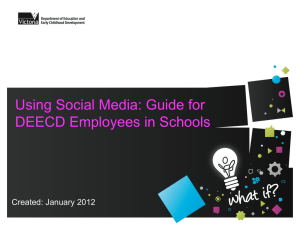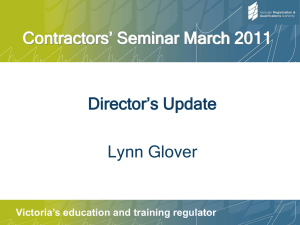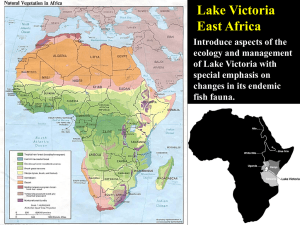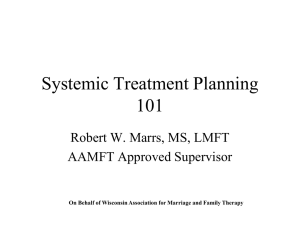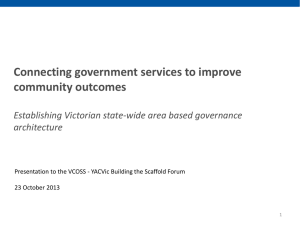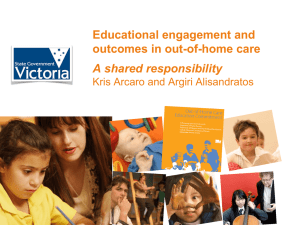Youth Partnerships - Department of Education and Early Childhood
advertisement
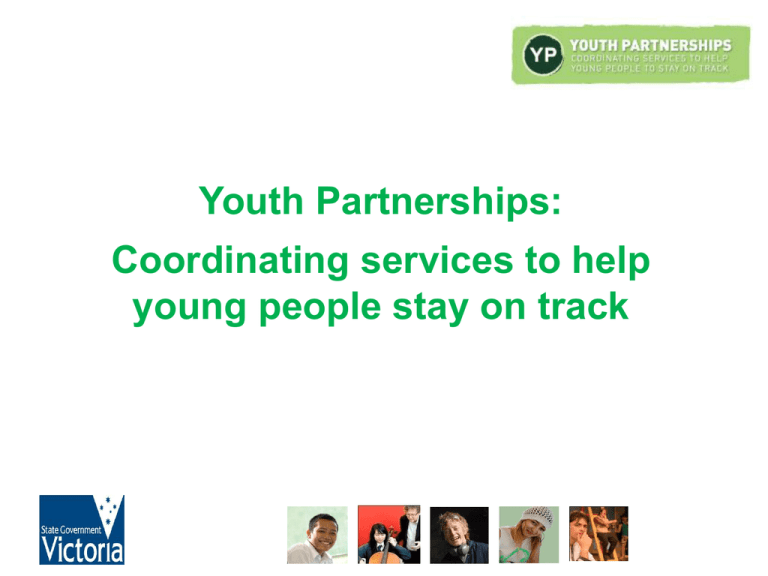
Youth Partnerships: Coordinating services to help young people stay on track Aims of Youth Partnerships • Strengthen collaboration and consistency in service provision to young people, in order to: • Improve engagement with education and training, leading to an increase in the completion of Year 12 or equivalent • Reduce escalation of problems for individual young people Demonstration Governance Board Membership Site WMR DEECD, DHS, CEO’s City of Wyndham and Hobson’s Bay, Victoria Police, LLEN,, Department Health, DEECD Regional Network Leaders EMR DEECD, DHS, Knox, Maroondah, Yarra Ranges Human Service Managers, LLEN, Victoria Police, Department Health, DPCD, Justice SMR DEECD, DHS, Frankston and Mornington Peninsula Council CEO’s, Department Health, Justice, Victoria Police BSW DEECD, DHS, CEO’s City of Greater Geelong, Surf Coast Shire, Borough of Queenscliffe Department Health, Justice, Victoria Police, 2 Nominated Community Service agencies, Associate Professor Swinburne Uni Grampians DEECD, DHS, CEO’s Shires of Moorabool, Hepburn, Golden Plains, Pyrenees, City of Ballarat, Department Health, RDV, DPCD, LLEN, Catholic Ed, Victoria Police LMR DEECD, DHS, CEO’s Shire Central Goldfields, City of Greater Bendigo, Swan Hill Rural City Council, Justice, Department Health, Catholic Ed, Centrelink, LLEN, Aboriginal Rep Group, Child Youth and Family Service Alliances Disengaged Young People Estimated 15-18 years disengaged (2007) 6.00% 5.10% 5.00% 4.40% 4.80% 4.60% 4.40% 4.00% 3.60% 3.70% 3.70% SMR NMR 3.70% 3.00% 2.20% 2.00% 1.00% 0.00% BSW Gramps LMR Hume Gipps EMR WMR Victoria LGA level data has been estimated from a combination of ABS 2006 Census data and ABS 2007 Survey of Education and Work data The Costs of Disengagement Individual Government Society Less highly educated offspring Decreased financial security Decreased cultural enjoyment Lower tax revenue Increased demand on the health system Higher costs of crime prevention Increased administration costs of social welfare Lower levels of education Lower health status Increased crime Generally decreased social interations and contributions to the community An early school leaver can expect to earn approximately $500,000 less than some who completes year 12 (1) Unemployment benefits of $80 million per annum and failure to realise $3.5 billion in tax revenue (2) Social benefits are conservatively estimated as 20% of any increase in market earnings For every dollar that government invests in retaining early school leavers, the expected return is as much as 3.2 times more Average days of student absence (%) 2006 - 2009 25 Days of Absence per year 20 15 10 5 0 2006 2007 2008 2009 Year 5 12.9 13.1 13.6 14 Year 6 13.4 13.4 13.8 14.4 Year 7 14.8 14.9 15.2 16.2 Year 8 18.1 18.3 18.8 19.8 Year 9 19.9 20.2 21.2 22.5 Year 10 18.1 18.4 19.6 20.9 Year 11 14.1 13.5 14.9 15.8 Year 12 11 10.9 11.7 13 Education Partnerships Across Victoria – the Context Breakdown of types of partnerships by number of schools Demonstration Sites Building on existing activity and the work of the Better Youth Service Pilots: • Barwon South West – Identifying Young people at risk of Homelessness – Model of improving outcomes for young people in residential care – Cross sectoral tracking and referral – Flexible learning setting • Grampians – Flexible Learning Individual Pathways learning centre – Outcome Star tool for case management – Outreach Teaching Support • Loddon Mallee – Place based governance – Models of integrated service delivery – Flexible learning and case management – ICAN Demonstration Sites • Yarra Ranges, Maroondah and Knox – No Wrong Door – Improved referral processes – Service usage data tool – Early identification tool • Frankston and Mornington Peninsula – Outreach teaching – Oakwood – Multi agency planning • Wyndham and Hobsons Bay – Processes to link schools and external services – Visible access point for advice, needs assessment and referral – Improve access to services Secretariat activity • Research data base • Common Practice Framework • Privacy Impact Assessment • Finance and Governance Project • Consultation with vulnerable young people • Proposed data investigation • Building an understanding of what’s happening outside the demonstration sites • Evaluation Summary Problem Young People Disengaged or At Risk of Disengagement Aiming to achieve Engaged Healthy Young People Options to reduce service fragmentation Fragmented service provision Understand the systemic barriers related to funding of service provision Inconsistent response Consolidate evidence of best practice Create effective mechanisms to share information Inconsistent early identification Establish a common language and identification mechanism Inadequate understanding of young people at risk or disengaged Establish a systemic data baseline to understand who the young people are and where they are Next Steps • Investigate data collected and opportunity to create a systemic data baseline • Effective mechanisms to share information • Consider options to be tested for vulnerable groups: – Unaccompanied minors – Young people in Residential Care – Young people in Justice Facilities – Young people in the Homeless system Further information • Visit: www.education.vic.gov.au/sensecyouth/youthpartnerships • Email: youth.partnerships@edumail.vic.gov.au
